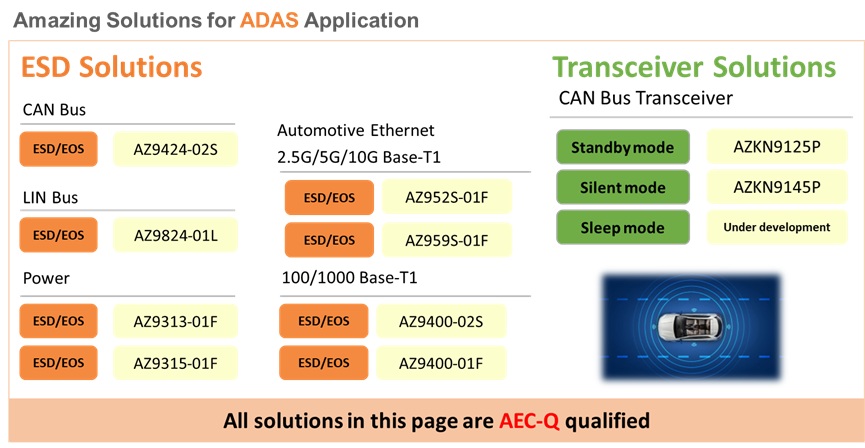Amazing AZ9400-01F : ADAS System Transmission and Protection in Automotive Applications Solutions for CAN Bus and In-Vehicle Ethernet Protection
Trends in ADAS Development
With the rapid advancement of smart vehicles and autonomous driving technologies, Advanced Driver Assistance Systems (ADAS) have become an essential core feature of modern automobiles. ADAS uses sensors—such as cameras, radar, and LiDAR—alongside control units to enable functions like automatic braking, lane departure warnings, and automated parking, thereby enhancing driving safety and comfort.
These features require the real-time processing of massive amounts of data, making in-vehicle communication architecture increasingly critical. Traditional CAN Bus technology is widely used in powertrain and chassis control due to its high reliability, low cost, and support for multiple nodes. However, standard CAN supports transmission speeds of only up to 1 Mbps. Even with the improvement of CAN FD to 8 Mbps, it still falls short of handling the large volumes of image and sensor data required by ADAS.
To address this limitation, the automotive industry is gradually adopting high-speed in-vehicle Ethernet technologies—such as 100BASE-T1 and 1000BASE-T1—to deliver higher bandwidth and lower latency. Future in-vehicle networks are expected to evolve into a hybrid architecture where CAN handles the reliable transmission of control signals, while Ethernet manages high-data-rate applications, supporting the needs of intelligent and autonomous driving.
Automotive Safety Protection
Since automotive electronic systems must operate long-term under harsh conditions, their safety and reliability requirements are much stricter than those of consumer electronics. ESD (Electrostatic Discharge) is a common and destructive threat, often introduced during assembly, maintenance, or daily operations by human touch or tools. Without proper protection, ESD can damage controller chips, potentially causing ADAS malfunctions or even compromising driving safety. To mitigate this, international standards such as ISO 10605 and AEC-Q101 impose strict ESD testing and protection requirements on automotive electronic modules. Modern automotive electronic designs must integrate ESD protection components into key communication interfaces like CAN Bus or Automotive Ethernet to ensure stable operation under ESD strikes as high as ±15kV, avoiding reliability and safety issues caused by ESD.
Amazing CAN Transceiver
To meet the high ESD protection requirements of ADAS systems, Amazing has developed CAN Bus components that not only provide complete CAN transceiver functionality and component-level ESD protection but also integrate system-level ESD and surge (8/20µs) protection into a single component. This enhances the transceiver's tolerance and helps reduce the risk of electrical overstress (EOS) from surges during system design, as shown in Figure 1.
Moreover, Amazing’s automotive-grade CAN Bus components comply with IEC 11898-2 and have passed multiple reliability certifications including IEC 62228-3 and AEC-Q100. To meet the various low-power mode requirements in automotive applications, Amazing offers a series of CAN transceivers with different power modes, including AZKN9125P (Standby Mode), AZKN9145P (Silent Mode), and upcoming Sleep Mode products. These components are not only suitable for ADAS systems but also widely applicable to a variety of automotive electronic systems, catering to diverse design needs.

Figure 1. Amazing CAN transceiver core technology
Automotive Ethernet ESD Protection
In addition to the widespread use of CAN Bus in vehicles, the growing demand for high-speed data transmission in ADAS has accelerated the adoption of Automotive Ethernet. To support this trend, Amazing has launched a series of TVS protection components compliant with the Open Alliance 100BASE-T1 and 1000BASE-T1 standards.
Among them, the AZ9400-01F uses an ultra-compact DFN1006 package, ideal for space-constrained applications. The AZ9400-02S offers dual-channel protection in a SOT23-3L package, meeting the need for multi-bus protection. For future high-speed interfaces like 2.5GBASE-T1 or Multi-G, Amazing has developed low-parasitic-capacitance designs such as AZ959S-01F and AZ952S-01F, effectively reducing signal loss and maintaining high-speed transmission quality. A complete ADAS ESD protection solution is shown in Figure 2.
Amazing’s protection solutions significantly enhance the ESD robustness and system stability of ADAS, laying a solid foundation for the safety and functionality of intelligent vehicles. Moving forward, Amazing will continue to develop higher-spec and more diversified package solutions to support customers in embracing the new era of high-speed automotive communication.

Figure 2. Amazing CAN transceiver and TVS solutions for ADAS